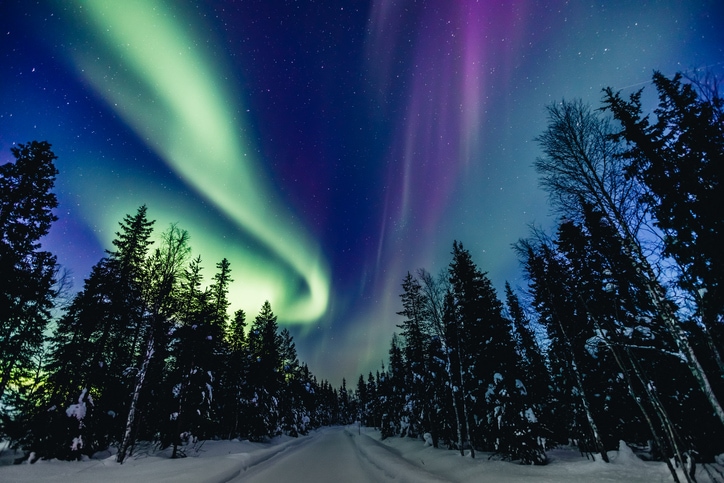Are Aurora Borealis Visible from Space?
At VALO Finland, we are passionate about sharing the wonders of Lapland with our guests. One of the most awe-inspiring natural phenomena that visitors to our luxury retreats often seek is the aurora borealis, or northern lights. But have you ever wondered if these spectacular light displays are visible from space? In this blog post, we delve into this fascinating question and provide a comprehensive understanding of the aurora borealis from both terrestrial and extraterrestrial perspectives.
Understanding the Aurora Borealis
The aurora borealis, commonly known as the northern lights, is a natural light display predominantly seen in high-latitude regions around the Arctic and Antarctic. These lights are caused by the interaction between solar wind particles and the Earth’s magnetic field. When charged particles from the sun collide with gases in the Earth’s atmosphere, they emit light, creating the stunning visual displays we see in the night sky.
In Finnish Lapland, the aurora borealis is a frequent visitor, especially during the long, dark winter nights. The best time to witness this phenomenon is between September and March, when the skies are dark and clear. The northern lights can appear in various colours, including green, pink, red, yellow, and blue, depending on the type of gas particles involved in the collisions.
Can the Aurora Borealis Be Seen from Space?
Yes, the aurora borealis is indeed visible from space. Astronauts aboard the International Space Station (ISS) and other satellites have captured breathtaking images and videos of the northern lights from their unique vantage points. From space, the auroras appear as vast, glowing curtains of light that stretch across the polar regions of the Earth.
These space-based observations provide a different perspective on the auroras, showcasing their immense scale and beauty. The ability to see the aurora borealis from space has also allowed scientists to study this phenomenon in greater detail, leading to a better understanding of the processes that drive these spectacular light displays.
What Astronauts Have Said About Seeing the Northern Lights from Space
Astronauts who have had the privilege of witnessing the aurora borealis from space often describe it as one of the most beautiful and awe-inspiring sights they have ever seen. The view from the ISS, orbiting approximately 400 kilometres above the Earth, offers a unique perspective on the auroras, allowing astronauts to see the full extent of these light displays as they dance across the polar regions.
For instance, astronaut Chris Hadfield, who served as the commander of the ISS, has shared numerous images and videos of the auroras from space, describing them as “a beautiful, ethereal display of light.” These firsthand accounts highlight the universal appeal and wonder of the aurora borealis, whether viewed from the ground or from space.
The Science Behind the Aurora Borealis: How and Why They Occur
The aurora borealis is a result of complex interactions between the solar wind, the Earth’s magnetic field, and the atmosphere. The sun constantly emits a stream of charged particles known as the solar wind. When these particles reach the Earth, they are guided by the planet’s magnetic field towards the polar regions.
As the charged particles collide with atoms and molecules in the Earth’s atmosphere, they transfer energy to these particles, causing them to become excited. When the excited particles return to their normal state, they release energy in the form of light. The specific colours of the auroras depend on the type of gas involved in the collisions. For example, oxygen produces green and red lights, while nitrogen produces blue and purple lights.
Capturing the Aurora Borealis from Space: Technology and Imagery
Modern technology has made it possible to capture stunning images and videos of the aurora borealis from space. Satellites equipped with advanced imaging sensors can detect the light emitted by the auroras and transmit these images back to Earth. The ISS, with its onboard cameras and sensors, also plays a crucial role in capturing and studying the auroras.
These space-based observations provide valuable data for scientists studying the auroras and the underlying processes that drive them. By analysing the images and data collected from space, researchers can gain insights into the behaviour of the solar wind, the Earth’s magnetic field, and the atmosphere, leading to a better understanding of this captivating natural phenomenon.
At VALO Finland, we are dedicated to providing our guests with unforgettable experiences in the heart of Finnish Lapland. Our luxury retreats offer the perfect setting to witness the aurora borealis in all its glory. Whether you are gazing at the northern lights from the comfort of your villa or exploring the pristine wilderness with an expert guide, we are here to make your Lapland adventure truly magical.
For more information on how to experience the aurora borealis and other wonders of Lapland, visit our website or contact us today. Let us help you create memories that will last a lifetime.
